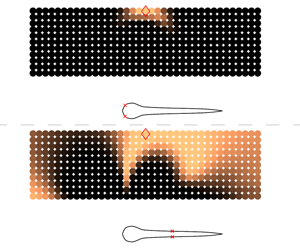Crossref Citations
This article has been cited by the following publications. This list is generated based on data provided by
Crossref.
Colvert, Brendan
Liu, Geng
Dong, Haibo
and
Kanso, Eva
2020.
Flowtaxis in the wakes of oscillating airfoils.
Theoretical and Computational Fluid Dynamics,
Vol. 34,
Issue. 4,
p.
545.
Weber, Pascal
Arampatzis, Georgios
Novati, Guido
Verma, Siddhartha
Papadimitriou, Costas
and
Koumoutsakos, Petros
2020.
Optimal Flow Sensing for Schooling Swimmers.
Biomimetics,
Vol. 5,
Issue. 1,
p.
10.
Yen, Wei-Kuo
Huang, Chen-Fen
Chang, Hong-Ruei
and
Guo, Jenhwa
2021.
Localization of a leading robotic fish using a pressure sensor array on its following vehicle.
Bioinspiration & Biomimetics,
Vol. 16,
Issue. 1,
p.
016007.
Gunnarson, Peter
Mandralis, Ioannis
Novati, Guido
Koumoutsakos, Petros
and
Dabiri, John O.
2021.
Learning efficient navigation in vortical flow fields.
Nature Communications,
Vol. 12,
Issue. 1,
Xu, Dong
Zhang, Yuanlin
Tian, Jian
Fan, Hongjie
Xie, Yifan
and
Dai, Wei
2021.
Optimal Sensor Placement of the Artificial Lateral Line for Flow Parametric Identification.
Sensors,
Vol. 21,
Issue. 12,
p.
3980.
Ashraf, Intesaaf
Van Wassenbergh, Sam
and
Verma, Siddhartha
2021.
Burst-and-coast swimming is not always energetically beneficial in fish (Hemigrammus bleheri).
Bioinspiration & Biomimetics,
Vol. 16,
Issue. 1,
p.
016002.
Paris, Romain
Beneddine, Samir
and
Dandois, Julien
2021.
Robust flow control and optimal sensor placement using deep reinforcement learning.
Journal of Fluid Mechanics,
Vol. 913,
Issue. ,
Zhai, Yufan
Zheng, Xingwen
and
Xie, Guangming
2021.
Fish Lateral Line Inspired Flow Sensors and Flow-aided Control: A Review.
Journal of Bionic Engineering,
Vol. 18,
Issue. 2,
p.
264.
Li, Gen
Kolomenskiy, Dmitry
Liu, Hao
Thiria, Benjamin
and
Godoy-Diana, Ramiro
2022.
Hydrodynamical Fingerprint of a Neighbour in a Fish Lateral Line.
Frontiers in Robotics and AI,
Vol. 9,
Issue. ,
Chao, Li-Ming
Mahbub Alam, Md.
and
Cheng, Liang
2022.
Hydrodynamic performance of slender swimmer: effect of travelling wavelength.
Journal of Fluid Mechanics,
Vol. 947,
Issue. ,
Caverly, D.
and
Nedić, J.
2022.
Estimating wind velocity and direction using sparse sensors on a cylinder.
Physics of Fluids,
Vol. 34,
Issue. 9,
Liu, Yanwen
and
Jiang, Hongzhou
2022.
Research Development on Fish Swimming.
Chinese Journal of Mechanical Engineering,
Vol. 35,
Issue. 1,
Fathurrohim, Luqman
Zuhal, Lavi Rizki
Palar, Pramudita Satria
and
Dwianto, Yohanes Bimo
2022.
Maximizing the thrust performance of flexible caudal fin panels via experimental optimization.
Ocean Engineering,
Vol. 266,
Issue. ,
p.
112969.
Cantero‐Chinchilla, Sergio
Papadimitriou, Costas
Chiachío, Juan
Chiachío, Manuel
Koumoutsakos, Petros
Fabro, Adriano T.
and
Chronopoulos, Dimitrios
2022.
Robust optimal sensor configuration using the value of information.
Structural Control and Health Monitoring,
Vol. 29,
Issue. 12,
Liu, Yu
Hu, Qiao
Yang, Qian
Fu, Tongqiang
and
Li, Sihu
2023.
The relative perception system of underwater bionic vehicles based on the artificial lateral line pressure sensor array.
Flow Measurement and Instrumentation,
Vol. 93,
Issue. ,
p.
102404.
Wang, Chengyun
Yu, Peng
and
Huang, Haibo
2023.
Reinforcement-learning-based parameter optimization of a splitter plate downstream in cylinder wake with stability analyses.
Physical Review Fluids,
Vol. 8,
Issue. 8,
Yuen, Ka-Veng
Zhang, Wen-Jing
and
Yan, Wang-Ji
2023.
Bayesian nonparametric general regression with adaptive kernel bandwidth and its application to seismic attenuation.
Advanced Engineering Informatics,
Vol. 55,
Issue. ,
p.
101859.
Xu, Wenhua
Xu, Guodong
Li, Mingjue
and
Yang, Chen
2023.
Bio-inspired wake tracking and phase matching of two diagonal flapping swimmers.
Physics of Fluids,
Vol. 35,
Issue. 3,
Kwok, K.C.S.
and
Hu, Gang
2023.
Wind energy system for buildings in an urban environment.
Journal of Wind Engineering and Industrial Aerodynamics,
Vol. 234,
Issue. ,
p.
105349.
Gao, Huanxiang
Liu, Junle
Lin, Pengfei
Hu, Gang
Patruno, Luca
Xiao, Yiqing
Tse, K.T.
and
Kwok, K.C.S.
2023.
An optimal sensor placement scheme for wind flow and pressure field monitoring.
Building and Environment,
Vol. 244,
Issue. ,
p.
110803.
